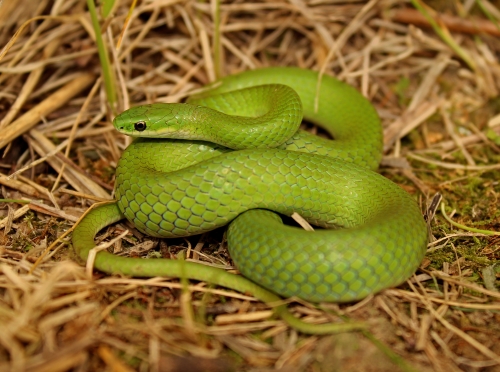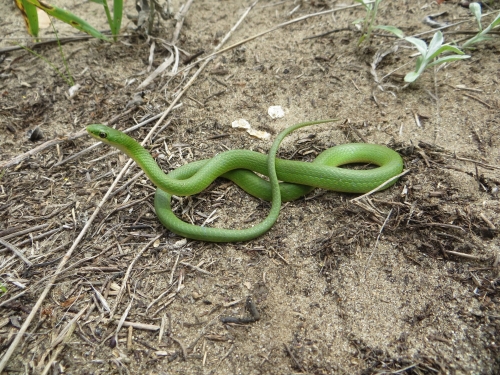Plants and Animals
Opheodrys vernalis Smooth green snake
Key Characteristics
The Smooth Greensnake is the only snake species in Michigan that is bright green in color, with occasional individuals that are light brown or tan in color. It is a medium-sized snake with adult lengths of 30.4 to 66 cm (12-26 in). The head is only slightly wider than the neck and is green on the upper surface with yellow or white on the lip, chin, and throat. The underside is white, ivory, or pale yellow. Snakes that are about to shed their skin may appear olive green but will return to bright green after shedding. Hatchlings and small juveniles tend to be duller in color with most olive green in color and a few brownish or bluish-gray.
Status and Rank
US Status: No Status/Not Listed
State Status: SC - Special Concern (rare or uncertain; not legally protected)
Global Rank: G5 - Secure
State Rank: S3 - Vulnerable
Occurrences
| County | Number of Occurrences | Year Last Observed |
|---|---|---|
| Alcona | 3 | 2014 |
| Alger | 5 | 2022 |
| Allegan | 1 | 2000 |
| Alpena | 5 | 2022 |
| Antrim | 4 | 2024 |
| Arenac | 1 | 1950 |
| Baraga | 5 | 2018 |
| Benzie | 3 | 2017 |
| Charlevoix | 2 | 2018 |
| Cheboygan | 9 | 2024 |
| Chippewa | 6 | 2024 |
| Clare | 2 | 1979 |
| Clinton | 1 | 1957 |
| Crawford | 9 | 2024 |
| Delta | 7 | 2024 |
| Dickinson | 2 | 2014 |
| Emmet | 9 | 2023 |
| Gladwin | 4 | 2022 |
| Gogebic | 3 | 2010 |
| Grand Traverse | 7 | 2015 |
| Houghton | 3 | 2018 |
| Huron | 3 | 2018 |
| Iosco | 6 | 2024 |
| Iron | 6 | 2018 |
| Isabella | 2 | 2014 |
| Jackson | 1 | 1922 |
| Kalkaska | 6 | 2023 |
| Lake | 1 | 2014 |
| Leelanau | 3 | 2022 |
| Livingston | 3 | 1959 |
| Luce | 3 | 2008 |
| Mackinac | 7 | 2018 |
| Macomb | 1 | 2012 |
| Manistee | 5 | 2022 |
| Marquette | 7 | 2022 |
| Mason | 2 | 2014 |
| Mecosta | 2 | 2016 |
| Menominee | 2 | 2024 |
| Midland | 3 | 2024 |
| Missaukee | 3 | 2018 |
| Montmorency | 6 | 2025 |
| Oakland | 3 | 2012 |
| Ogemaw | 1 | 2025 |
| Ontonagon | 3 | 2018 |
| Oscoda | 6 | 2025 |
| Otsego | 8 | 2025 |
| Presque Isle | 5 | 2024 |
| Roscommon | 2 | 2018 |
| Sanilac | 1 | 2003 |
| Schoolcraft | 5 | 2017 |
| St. Clair | 1 | 2018 |
| Van Buren | 1 | 2001 |
| Wexford | 2 | 2025 |
Information is summarized from MNFI's database of rare species and community occurrences. Data may not reflect true distribution since much of the state has not been thoroughly surveyed.
Habitat
This snake usually occurs in moist, grassy habitats such as prairies, savannas, meadows, old fields, pastures, roadsides, vacant lots, stream borders, and marsh and lake edges. They also can be found in open moist deciduous and pine forests and along forest edges. They will forage, bask on, and/or hide in or under stumps, logs and other woody debris, low shrubs, rocks, or anthropogenic debris such as boards or concrete. They lay their eggs in or under rotting wood, underground in burrows, or under logs, rocks, boards or other similar cover objects. They overwinter in abandoned ant hills and small mammal burrows. They may hibernate communally with other small snakes.
Natural Community Types
- Coastal fen
- Dry-mesic northern forest
- Dry-mesic prairie
- Dry-mesic southern forest
- Lakeplain oak openings
- Lakeplain wet prairie
- Lakeplain wet-mesic prairie
- Mesic northern forest
- Mesic prairie
- Mesic sand prairie
- Mesic southern forest
- Northern fen
- Northern wet meadow
- Oak barrens
- Oak-pine barrens
- Pine barrens
- Prairie fen
- Southern shrub-carr
- Southern wet meadow
- Wet prairie
- Wet-mesic prairie
- Wet-mesic sand prairie
For each species, lists of natural communities were derived from review of the nearly 6,500 element occurrences in the MNFI database, in addition to herbarium label data for some taxa. In most cases, at least one specimen record exists for each listed natural community. For certain taxa, especially poorly collected or extirpated species of prairie and savanna habitats, natural community lists were derived from inferences from collection sites and habitat preferences in immediately adjacent states (particularly Indiana and Illinois). Natural communities are not listed for those species documented only from altered or ruderal habitats in Michigan, especially for taxa that occur in a variety of habitats outside of the state.
Natural communities are not listed in order of frequency of occurrence, but are rather derived from the full set of natural communities, organized by Ecological Group. In many cases, the general habitat descriptions should provide greater clarity and direction to the surveyor. In future versions of the Rare Species Explorer, we hope to incorporate natural community fidelity ranks for each taxon.
Management Recommendations
Main threats to this species are pesticide use and habitat loss due to conversion to intensive agricultural use. Because this species feeds primarily on insects, they are particularly vulnerable to the direct and indirect effects of pesticides that are widely sprayed in agricultural areas as well as residential areas. Maintaining and protecting suitable habitats within extant populations are critical to conservation of this species. Minimizing the use of pesticides within and adjacent to occupied habitats would help maintain sufficient prey and reduce the potential for adverse impacts to extant populations of this species. Targeted surveys and research are needed to obtain enhanced information and a better understanding of this species’ current status and distribution, ecology, particularly habitat requirements, and specific threats facing the state’s remaining populations. Surveys to assess and monitor the prevalence of snake fungal disease in extant populations also are needed to assess impact of this disease and determine if and when management is warranted.
Active Period
Active from second week of April to fourth week of October
Breeding from third week of April to fourth week of August
Nesting from third week of June to second week of September
Survey Methods
Surveys can be conducted any time during the active season. The best way to survey for this species is with visual surveys in which observers walk slowly through areas with suitable habitat looking for snakes primarily under cover objects (e.g., downed woody debris, stumps, logs, rocks, etc.) as well as individuals basking, resting, foraging, or moving on the surface. Artificial cover surveys which consist of placing and checking coverboards (e.g., plywood) in the field also may be effective and could complement visual surveys. Surveys should be conducted under appropriate weather conditions during which the species is expected to be active and/or visible (i.e., between 60-80°F [16-27°C], wind less than 15 mph, no or light precipitation). Multiple survey visits to the same site should be conducted.
Cover board survey
Survey Period: From second week of April to fourth week of October
Time of Day: Daytime
Air Temperature: Above 60 degrees
Precipitation: Just after rain
Wind: No Wind
Visual encounter surveys
Survey Period: From second week of April to fourth week of October
Time of Day: Daytime
Air Temperature: Above 60 degrees
Precipitation: Just after rain
Wind: No Wind
References
Survey References
- Graeter, G.L., K.A. Buhlmann, L.R. Wilkinson, and J.W. Gibbons (editors). 2013. Inventory and Monitoring: Recommended Techniques for Reptiles and Amphibians. Partners in Amphibian and Reptile Conservation Technical Publication IM-1, Birmingham, AL. 321 pp.
- Karns, D.R. 1986. Field Herpetology: Methods for the Study of Amphibians and Reptiles in Minnesota. Occ. Pap. No. 18. J.F. Bell Museum of Natural History, University of Minnesota, Minneapolis.
Technical References
- Animal Diversity Web. “Opheodrys vernalis" (On-line), Accessed March 29, 2020 at https://animaldiversity.org/accounts/Opheodrys_vernalis/
- Ernst, C.H., and E.M. Ernst. 2003. Snakes of the United States and Canada. Smithsonian Books, Washington, D.C.
- Harding, J.H., and D.A. Mifsud. 2017. Amphibians and Reptiles of the Great Lakes Region, Revised Edition. University of Michigan Press, Ann Arbor, MI. 408 pp.
- NatureServe Explorer 2.0. 2020. <https://explorer.natureserve.org/> NatureServe, Arlington, VA. Accessed 29 Mar 2020.



